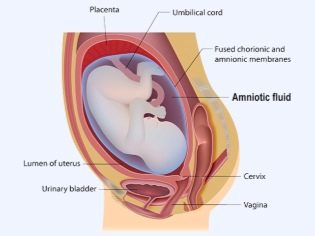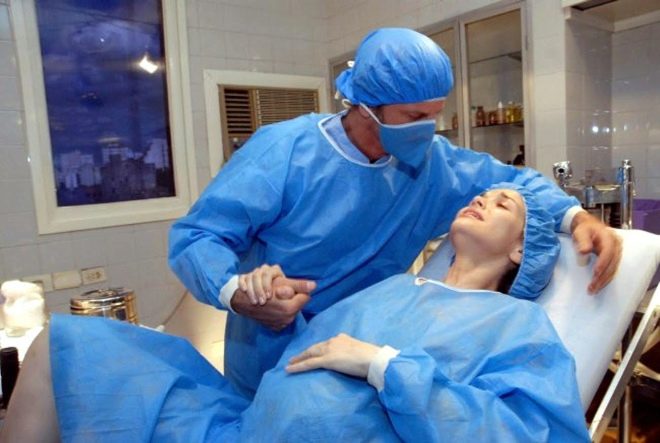After how many minutes do contractions usually begin after the discharge of water?
The process of childbirth is always very complex and in many ways individual. The sequence of stages described in the medical literature, as well as explained to women in the courses of expectant mothers, is not always the case in practice, and therefore a pregnant woman needs to be morally prepared for the most varied scenarios.
In this article we will talk about the characteristics of childbirth, which begins not with contractions, but with a sudden outpouring of water or a mechanical puncture of the fetal bladder.
Waterless childbirth
Ideal, from the point of view of obstetrics, are considered childbirth, which begins with the gradual development of contractions. The cervix is gradually smoothed, revealed, and only after the opening of the internal pharynx the pressure on the fetal bladder becomes large enough, it opens, and the waters drain. The attempts begin, and soon the baby is born.
In fact, childbirth often begins with the discharge of water. The baby resides in the mother's womb in a sterile environment - an amniotic fluid, which is enclosed together with the baby in an amniotic sac. If the walls of the membranes become thinner due to the diseases suffered by the woman during the childbearing period, if they are just thin by themselves, if the expectant mother was diagnosed with polyhydramniosa, then the outpouring of waters can happen before the contractions begin.
Often, rupture occurs when falling; it is especially dangerous for a pregnant woman to fall on her stomach, on her butt, on her back.
If the water is removed, it is very important that the contractions begin quickly enough, the cervix opens and the attempts begin. If labor activity is weak, slow, then the baby is at great risk.
In the absence of a sterile environment, which was water, it can become infected with viruses, bacteria, fungi, which can be fatal or have irreparable consequences.
A long anhydrous period, if the contractions do not occur in time, threatens with acute hypoxia, the development of posthypoxic brain damage. The consequences can be the most unpleasant: cerebral palsy, traumatic deformity of the child’s limbs and even the death of the crumbs.
Infectious pathogens that can enter the uterus of a woman during the anhydrous period can lead to a complete amputation of the genital organ and the inability to have children in the future.
In this regard, the question arises when the contractions begin after the discharge of water.
The answer is ambiguous. In obstetrics, it is believed that the forecasts will be favorable if the contractions begin no later than 3-4 hours after the discharge of water. If a child is more than 12 hours in a dry period, the development of serious consequences is not excluded. If the anhydrous period lasts longer than 48 hours, the death of the fetus and infection of the uterus in a woman becomes probable.
The task of the woman whose water has withdrawn is to immediately call an ambulance and go to the hospital as soon as possible. Sitting at home and waiting for the fight to begin, there is no point.
If the cervix is not at all ready for childbirth, in such situations a cesarean section is often performed to eliminate the risks to the baby.
But a specific decision should be made as soon as possible by qualified doctors after examination and evaluation of all circumstances. The outpouring of waters is the beginning of labor. Two opinions can not be.
What's next?
The outflow itself can be complete and partial.If the water only gradually leaks, the development of contractions can be permanently delayed. If at least 150-200 ml of water has simultaneously departed, it is a complete rupture of the bubble.
Consider premature rupture, which occurred if the cervix is not yet ready for childbirth, disclosure and no smoothing. If rupture occurs on the background of disclosing, contractions, then the early release of amniotic fluid is considered, when the neck is only 4 cm wide. Normally, water should be released when opening up to 5-6 centimeters. About the late withdrawal of water they say, if the bubble is not opened at full disclosure.
It is important and the place of perforation of the fetal sac - cervical or lateral. There are quite a few factors that influence the contractile activity of the uterus. If time passes, contractions do not begin after 4-6 hours, the issue of stimulating labor activity is decided.
Recently, doctors have somewhat revised the approach, which for a long time was the only generally accepted one - wait until the last. Previously, the rules prescribed doctors not to stimulate childbirth, even in the dry period for 12 hours.
After the shocking statistics of the Ministry of Health in recent years in the number of generic complications in children and women in labor with a long anhydrous period, It was recommended to provide stimulating assistance earlier.
Stimulation is carried out in the case of full-term pregnancy, not complicated by entanglement with the umbilical cord, with the child in the right headache, with a small fetus. In order for a woman to give birth, she is given the hormone oxytocin, which causes contractions of the smooth muscles of the uterus.
If the labor remains weak after stimulation, disclosure is slow, the decision is made to conduct an emergency cesarean section.
In a surgical way, a woman is delivered without waiting for the onset of labor, if:
- the separated water had a green, dark color, an unpleasant odor, a mixture of meconium (feces) is possible, this often signals the state of fetal hypoxia;
- there were blood impurities in the waters - pathological processes in the placenta are not excluded;
- The outpouring of waters was swift, with the result that parts of the baby’s body or umbilical cord loops dropped out of the water into the genital tract (with partial opening), if it is not possible to correct them, a caesarean section can be performed.
The unnatural color of the amniotic fluid and their unpleasant smell may indicate intrauterine infection, and therefore the child, for health reasons, needs to leave the mother's womb as soon as possible.
Be sure to tell your doctor upon arrival at the hospital about what color the water flowed away. This will help you choose the right tactic.
What to do if the water flowed out without contractions, you will learn from the following video.





















